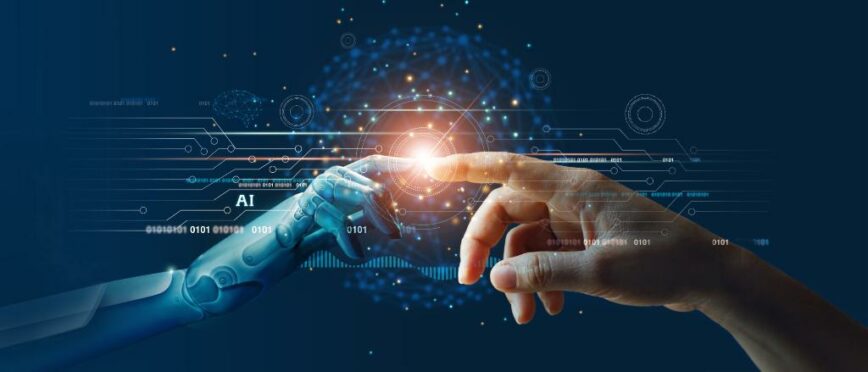AI Regulation: AI to Regulate Itself!

Believe it or not, in a few years, AI will be regulated by AI. This may sound outlandish, but AI regulation requires a volume of oversight that realistically only AI-driven technology could adequately handle the detection, reporting, and enforcement. The journey of AI, from its conceptual roots to its present omnipresence, has been nothing short of remarkable. What began as theoretical discussions in the 1950s evolved into practical applications in the 21st century.
For decades, the concept of Artificial Intelligence (AI) has fascinated audiences in the realm of science fiction and cinema. From the future war between the human race and artificial intelligence in the 2023 movie “The Creator” (pictured above – 20th Century Studios – The Creator) to the superintelligent computer HAL 9000 in “2001: A Space Odyssey,” AI has been a captivating theme that explores the boundaries of human imagination.
That said, what was once purely the stuff of Hollywood fantasy is now increasingly becoming a tangible reality. In recent years, AI has made remarkable strides, permeating our daily lives and transforming various industries, ushering in a new era where science fiction is merging with real-world innovation.
This transformation raises profound questions about the ethical, social, and practical implications of AI as it moves from the silver screen into our homes, workplaces, and societies at large. In this article, we will delve into the fascinating journey of AI and how AI self-regulation will be a reality in the near future.
Update: Since first publishing this article, Biden signs executive order to oversee and invest in AI. – The order is broad, and its focuses range from civil rights and industry regulations.
The Unstoppable Rise of AI
Deep learning, machine learning, and natural language processing are now standard technologies that drive everything from your smartphone’s voice assistant to large-scale data analysis and prediction in various industries. The rate and expanse of adoption have been astonishing, increasingly touching every facet of our lives and swiftly becoming the new backbone of modern technology.
From Amazon to Grammarly, from Quora to Spotify, from YouTube to Pinterest, from Adobe to earthquake detection, hospitals, cruise ships, wildlife conservation, law practice, and, well, you get the point! Put it this way: there is almost no industry that AI hasn’t already impacted.
Today, we often use AI without even realizing it. I’m thrilled to witness how rapidly and widely AI is being adopted, but I’m also eagerly looking forward to governments and organizations turning their focus more on AI regulation.
With multiple significant and ongoing global events in recent years, our attention has understandably been diverted. In just another year or two, many of us will reflect back and wonder: “When did this rise of AI happen?!” Very soon, governments and organizations will be forced to pivot their attention to the regulation of AI and generative AI.
Where Algorithms Meet Imagination
Generative AI (GenAI) is a revolutionary branch of artificial intelligence that focuses on creating content rather than simply processing or analyzing it. At its core, generative AI aims to replicate human-like creativity and imagination in the digital realm.
It uses advanced algorithms and deep learning techniques to generate new, original content such as text, images, music, or even entire narratives. One of the most well-known examples of generative AI is OpenAI’s GPT (Generative Pre-trained Transformer) models, which can understand context, generate human-like text, and even engage in meaningful conversations.
The Challenge of Regulating AI
The rapid expansion of AI also brings forth significant challenges in the realm of regulation.
Current internet regulations rely on legislative frameworks and largely manual oversight to enforce rules and policies. Laws like the General Data Protection Regulation (GDPR) in Europe aim to protect user data by requiring explicit user consent for data collection, while other regulations focus on issues like copyright infringement, illegal content, privacy, and online fraud.
However, these traditional forms of regulation are becoming increasingly impractical for managing the rapidly evolving landscape of AI. Human oversight simply can’t keep up with the vast amount of data and activities generated by AI systems.
The limitations of human-based regulations lie in scalability, agility, and capability. These challenges underscore the pressing need for a new kind of regulation and set the stage for why AI self-regulation is not just possible, but necessary, in our ever-advancing technological landscape.
AI Systems for Regulating AI
AI generates content at a pace that surpasses human capabilities, making it challenging to monitor and moderate effectively. Conventional regulatory approaches will find it impractical to keep up with the rapidly changing field of AI. However, regulation and privacy focus monitoring driven by AI systems has the potential to continually adapt, learn, and identify improper use in real-time.
“Trusting AI to regulate itself hinges on several factors that demonstrate its potential for responsible and effective self-regulation.”
Consider a scenario where governments – through open-source collaboration – deploy AI systems that monitor and prevent AI abuse and prioritize user privacy and anonymity. These AI sentinels would be designed to continuously observe online activities, safeguarding against the misuse of AI while respecting users’ rights to privacy and anonymity. Instead of relying on rigid, pre-defined rules, these AI systems would analyze patterns and detect anomalies in real-time, offering a more proactive and adaptive approach than traditional regulation.
Of course, companies and other non-governmental organizations can and will create AI-driven techniques and systems to address the complexities of AI regulation. Expect to see this as early as 2024.
Limitations and ethical challenges
AI regulating other AI systems introduces a complex set of challenges, particularly when it comes to ethical dilemmas, biases, and nuanced human contexts that are better understood by humans. While AI can efficiently detect patterns and anomalies, it may struggle with the moral and ethical dimensions of decision-making.
AI self-regulation may lack the ability to navigate intricate ethical dilemmas. Decisions that require a deep understanding of cultural, moral, or philosophical nuances could be challenging for them. For instance, determining the ethical boundaries of AI use in sensitive areas like healthcare.
AI can perpetuate biases present in its training data by inadvertently perpetuating or missing biases in the AI systems it monitors. Humans have the capacity to recognize and address these biases more effectively by considering the broader societal implications and context.
Many situations involve multifaceted complexities that may not have clear-cut solutions. In fact, the situations themselves, the majority of them, do not yet exist but will soon!
A Hybrid Approach

Artificial Intelligence, Human Influence
To address these challenges, a hybrid approach involving both AI and human expertise is essential. This approach recognizes that while AI can excel in tasks like monitoring and pattern recognition, human judgment remains indispensable when it comes to ethical considerations, nuanced decision-making, and understanding continually emerging complex contexts.
By combining the strengths of AI’s efficiency with human values and judgment, we can work toward a more balanced and effective system for regulating AI. This partnership ensures that AI-driven systems are not only technologically sound but also ethically and socially responsible, reflecting the diverse perspectives and values of the human societies they serve.
Technology Requirements
Effective AI self-regulation would require a combination of advanced algorithms, standards, and technologies to ensure responsible and proactive oversight. Here are some key components and technologies that would be necessary for this purpose:
Machine Learning and Deep Learning Algorithms: Self-regulating AI systems would need sophisticated machine learning and deep learning algorithms. These algorithms should be capable of continuous learning and adaptation to evolving AI behaviors and patterns.
Natural Language Processing (NLP): NLP technologies would be essential for understanding and interpreting human-generated content and conversations. They would help in identifying harmful or inappropriate language and context.
Computer Vision: For AI systems that involve visual content, computer vision algorithms would be necessary to analyze and assess images and videos, identifying any potentially harmful or misleading content.
Pattern Recognition: AI regulators should employ advanced pattern recognition algorithms to detect anomalies and deviations from established norms, which might indicate misuse or unethical behavior.
Ethical AI Frameworks: Incorporating ethical AI frameworks into the self-regulation process. Frameworks that guide designers of AI systems to better align their systems with human values and principles.
Interpretability and Explainability Tools: To build trust and transparency, AI regulators should include interpretability and explainability tools that can provide insights into how decisions are made, allowing humans to understand and scrutinize the reasoning behind AI actions.
Big Data Analytics and Anomaly Detection: Robust data analytics and anomaly detection technologies would enable AI regulators to process large volumes of data in real time, identifying outliers and potential violations quickly.
Collaborative Filtering: Collaborative filtering techniques can help AI regulators assess the impact of AI-generated content on individuals and communities, identifying content that might cause harm or division.
Cross-Platform Integration: Effective self-regulation would require AI systems to operate seamlessly across various platforms, networks, and applications, ensuring consistent monitoring and enforcement.
Why We Can Trust AI to Regulate Itself

Warner Bros. Entertainment Inc. – HAL 9000 in “2001: A Space Odyssey.
AI-related science fiction movies have a long history of portraying extreme scenarios involving artificial intelligence. These films often depict AI in two polarized extremes: as humane, highly advanced entities aiding humanity or as malicious, sentient machines seeking to dominate or even destroy humanity.
On the contrary, the AI systems we encounter today, such as voice assistants or recommendation algorithms, are designed with specific tasks in mind, and they lack the general intelligence and self-awareness portrayed in movies. AI development is heavily focused on solving practical problems, enhancing productivity, and improving the human experience.
The fear that AI will inevitably lead to catastrophic scenarios like those in sci-fi movies is not well-founded. Responsible AI development involves rigorous testing, ethical considerations, and human oversight to ensure AI systems are safe and aligned with human values. Rather than fearing frightening outcomes, we should focus on fostering ethical AI practices and ensuring that AI technologies continue to benefit humanity.
Trusting AI to regulate itself hinges on several factors that demonstrate its potential for responsible and effective self-regulation:
- AI has the capacity for continuous learning and adaptation, enabling it to stay ahead of emerging threats and challenges.
- AI operates based on predefined rules, standards, and algorithms, making its decision-making process transparent and auditable.
- AI can process vast amounts of data in real-time, allowing it to detect anomalies and address issues swiftly.
- AI-driven regulation can offer consistency and impartiality, reducing the potential for human biases and errors.
- AI self-regulation must provide a level of reliability and efficiency that traditional manual regulation finds impossible to achieve.
While challenges exist, these attributes position AI as a promising candidate for regulating itself responsibly in an increasingly AI-driven world.
How AI Systems Regulating AI Would Work
To understand how AI systems regulating AI would work, it’s essential to examine the mechanisms of interfacing between AI regulation systems and AI/Generative AI providers. This involves a combination of technological, legal, and ethical frameworks to ensure effective oversight and compliance:
- API Integration: AI regulatory systems could interface with AI and GenAI providers through Application Programming Interfaces (APIs). These APIs would allow regulatory AI to access, monitor, and analyze the data and operations of third-party AI systems in a structured manner. This is similar to how third-party applications integrate with larger platforms like social media or cloud services.
- Data Sharing Agreements: There would need to be data sharing agreements between AI regulatory bodies and AI/GenAI providers. These agreements would outline the extent and manner in which data can be shared and analyzed, ensuring compliance with privacy laws and ethical standards.
- Standardization of Protocols: The development of industry-wide standards and protocols for AI regulation would facilitate smoother interfacing between regulatory systems and AI providers. These standards would define how data is to be formatted, transferred, and used for regulatory purposes.
- Real-Time Monitoring Systems: AI regulatory systems would likely include real-time monitoring capabilities. This means they could continuously analyze data flows and operations of AI/GenAI systems to detect any anomalies, misuse, or deviation from accepted ethical and legal standards.
- Collaborative Filtering and Pattern Recognition: By using advanced pattern recognition and collaborative filtering techniques, AI regulators could assess the impact of AI-generated content and operations, ensuring they align with regulatory standards and ethical norms.
- Feedback Mechanisms: There would be feedback mechanisms in place where the regulatory AI can provide insights, warnings, or even enforce certain actions if non-compliance or unethical practices are detected. This feedback could be automated or may require human intervention in more complex scenarios.
- Blockchain for Transparency and Traceability: Blockchain technology could be employed to create a transparent and tamper-proof ledger of AI activities. This would enable a clear traceability of decisions and actions taken by AI systems, which is critical for accountability and regulation.
- Human Oversight Integration: Critical to this interface is the integration of human oversight. Decisions or actions suggested by the AI regulatory system that involve complex ethical considerations would be escalated to human regulators.
- Cybersecurity Protocols: Strong cybersecurity measures would be essential to protect the data and operations being monitored from unauthorized access or tampering.
- International Collaboration: International standards and protocols for AI self-regulation on a global scale, established by organizations like the United Nations, would provide a foundational framework for AI ethics and self-regulation.
Interfacing AI regulatory systems with AI, Chatbots and other generative AI providers would involve a combination of technological integration, standardization of protocols, real-time monitoring, ethical and legal compliance, and both automated and human oversight mechanisms. This multi-faceted approach ensures that AI regulation is effective, ethical, and adaptable to the rapidly evolving landscape of AI technology.
Forward-Looking Statement
For policymakers, international collaboration is crucial in developing consistent AI self-regulation standards. Clear ethical frameworks should guide AI behavior, and regulatory bodies need to oversee compliance and safeguard data privacy.
Developers play a pivotal role by designing transparency tools, addressing bias, and promoting ethical AI education. These efforts ensure AI systems are accountable, understandable, and aligned with ethical principles.
Corporations should prioritize user-centric design, granting users control over AI behavior. The use of open source, open standards, transparency by way of independent auditing, and investments in adaptable AI systems ensure their continuous alignment with evolving regulations and ethical standards.
Conclusion
As we navigate the ever-expanding landscape of AI and its integration into various aspects of our lives, the idea of AI regulating itself emerges as a forward-looking solution. Trusting AI to self-regulate is not without its challenges, but it offers the promise of efficient, adaptive, and consistent oversight in a global and dynamic context. The alternative to AI self-regulation involves manual human intervention and the creation of laws and legislation to control the expanding AI landscape.
With the right checks and balances, AI can navigate ethical dilemmas, biases, and complexities, albeit with room for improvement. As we embrace this technological future, the concept of AI self-regulation forces us to ponder the immense responsibility and potential that AI carries in shaping the way we interact with technology, each other, and the world at large.
It’s a journey that requires careful consideration, collaboration, and continual evolution to ensure a harmonious coexistence of AI and humanity.
References/reading:
- UN AI Advisory Body – High-level Advisory Body on Artificial Intelligence.
- AI for Good Global Summit – A leading action-oriented United Nations platform for AI.
-
EU AI Act – first regulation on artificial intelligence.
- Gartner AI Summit – Gartner Data & Analytics Summit.
Edit: A reader just shared this article from this morning:
Thanks @Christine
Definitely agree. Recently, I updated my smart home system making voice recognition much more accurate so cool!
Has anyone seen https://www.josh.ai/ ?
I’m afraid I’m troubled by this phrase ‘AI self-regulation’. I’m sure no AI system is regulating itself exactly - such an actuality sounds contorted.
Rather, and as you’ve variously expressed, one AI system would be regulated by another and conflating these as thoroughly as you seem to have done, is unwise, if I may suggest.
Self-regulation is a negative phrase (c.f. banking); a poor version of proper regulation and in my opinion should not be popularised with respect to AI, when it does not apply. It can only lead to corruption of the public impression of its use (cf. CoViD-19) via headline writers re-iterating such a phrase coming from careless tech authors.
Does that sound fair?
I appreciate your insights. It’s important to clarify that when I referred to ‘AI self-regulation,’ I meant that AI systems would play a role in regulating themselves, not in isolation but as part of a broader regulatory framework involving multiple AI systems.
I understand your concerns about the term “AI self-regulation” having potentially negative connotations, and I’ll make sure to be more precise in my future articles to avoid any confusion. Thank you for your thoughtful input.
So yes, in the future, AI (AI systems) will be used to regulate other AI (other AI systems).